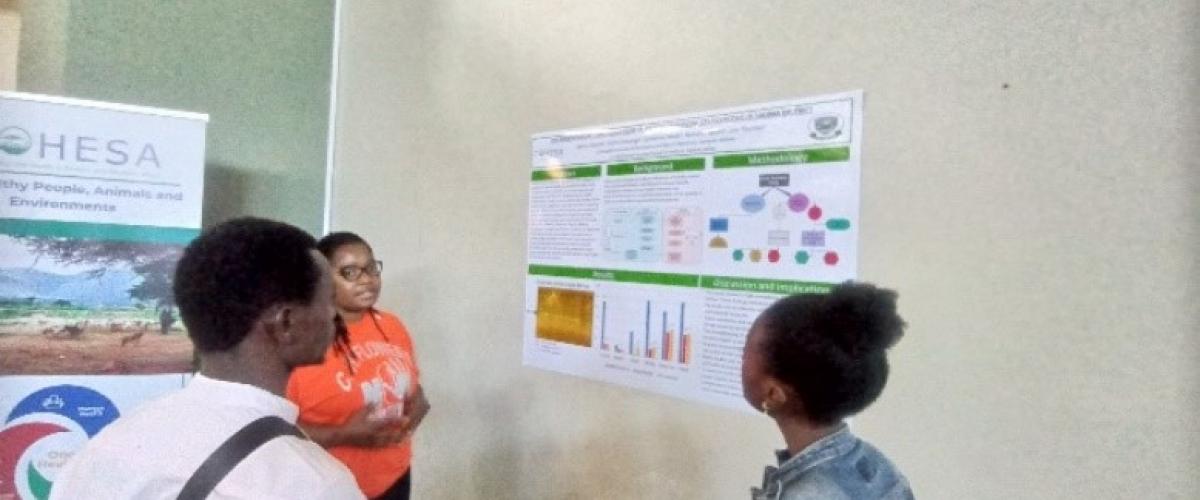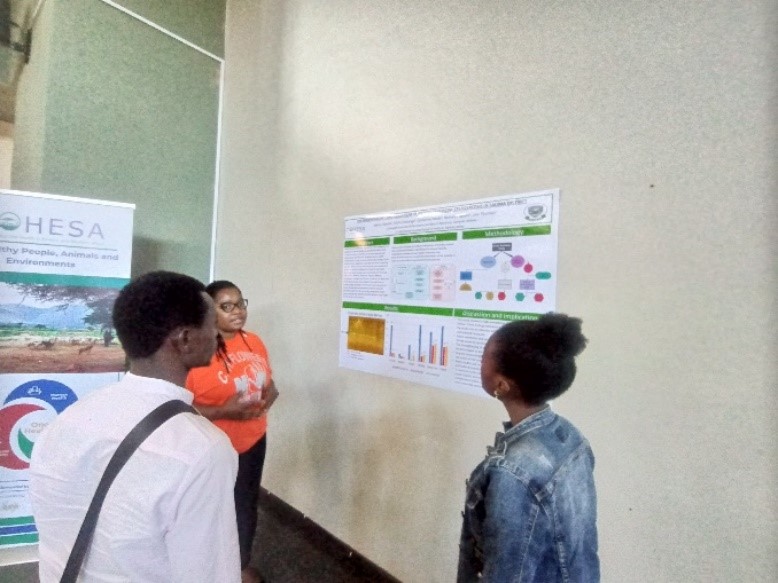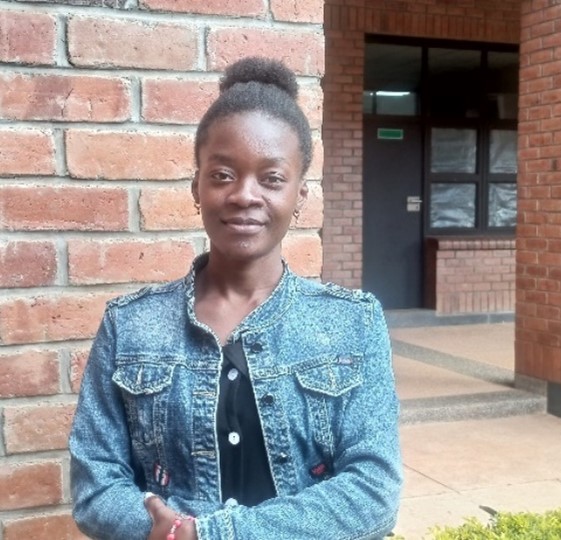
For the last five years, the International Livestock Research Institute (ILRI) has supported final year Bachelor of Veterinary students at the Lilongwe University of Agriculture and Natural Resources (LUANAR) in Malawi to conduct research projects in fulfillment of the undergraduate studies at the university. Current support through the One Health Research Centre in Africa (OHRECA) and comprises of funding, technical support and mentoring to the young scientists.
On the sidelines of the 2nd Malawi One Health symposium held on 7-8th May 2024, some of the beneficiaries of the ILRI CapDev program shared about their work and career prospects.
 Comfort Joseph Jiya- Seroprevalence of brucella abortus and Coxiella burnetii in bovan dairy herds in Malawi.
Comfort Joseph Jiya- Seroprevalence of brucella abortus and Coxiella burnetii in bovan dairy herds in Malawi.
Comfort’s research was inspired by the varied information on Brucellosis and a lack of updated data on Coxiella burnetii in Malawi. While 7.7% prevalence has been reported in the northern part of the country, and no cases the southern region, the status for the central region remains unknown. On the other hand, the current prevalence for Coxiella burnetii is also unknown since the last research was conducted more than 35 years ago in 1989 and there has not been any information since then. A 2020 publication reported that 2 Japanese who had visited Malawi had tested positive for acute Q fever, a disease caused by Coxiella burnetti, on return to Japan.
Brucella and Coxiella burnetii are pathogenic bacteria that can cause large-scale outbreaks in livestock. Furthermore, these infectious agents can cause zoonotic infections and therefore pose a risk to the close relationship between farm households and their livestock.
Serum and milk samples were collected from the southern region in Malawi and preliminary results indicate no antibodies found in serum. However, 11/120 milk samples tested positive for Brucellosis and 4/120 samples were positive for Coxiella.
While the results were initially surprising, the One Health symposium provided a green light.
“I was surprised that while there were no Brucellosis or Coxiella antibodies in the serum samples, there were some in the milk samples. Fortunately, at this One Health symposium, I shared my findings with some senior scientists who have offered guidance on some further tests I can conduct and have also offered to review my work and help him understand and interpret the results”.
Comfort is interested in the interface of animal and human health and hopes to pursue a career in Microbiology and research. The interactions at the symposium further strengthened his belief that both animal and human health practitioners can promoter health better, if they work together.
 Mercy Chavula- Seroprevalence and molecular detection of Porcine Cysticercosis in Salima district
Mercy Chavula- Seroprevalence and molecular detection of Porcine Cysticercosis in Salima district
Mercy loves to eat pork and her work drew from a personal experience when she was a freshman at the University. After enjoying roadside roasted pork, a colleague she was with informed her that the pork had ‘sejje’, the larvae stage of tapeworm. Incensed by what she initially thought was ignorance of the butchers, Mercy was to later find out that while such meat never passed routine inspection tests, the butchers knowingly bought it, because it was cheaper, putting the lives of consumers at risk of porcine cysticercosis infection resulting into severe headache, blindness convulsions, epileptic seizures and even death.
The ILRI funding gave her opportunity to conduct research in her area of interest. She worked with a team of ILRI researchers that were mapping Taenia solium hotspots in Malawi. While the main study was only mapping the hotspots, the funding from ILRI enabled her to conduct serology and molecular work, which is still a virgin area in Malawi.
“ Taenia solium work in Malawi has only been on inspection or selogy. But I was able to conduct both serology and molecular testing on the collected samples because of the funding support I received”.
Preliminary findings from her work show a 44% prevalence of Taenia solium in Salima district.
The second born in a family of nine children to now retired teachers, Mercy comes from a farming community and would like to use her knowledge to help the people in the northern,,,,region of Malawi where she comes from. She would like to continue work on Taenia solium, specifically sequencing tapeworm and contribute to building the body on knowledge in Malawi and provide research based evidence on common zoonotic diseases, which says is still weak.
 Charles Nkhoma – Prevalence of Extended-spectrum beta-lactamases ecoli from healthy pigs and cattle slaughtered in Lilongwe
Charles Nkhoma – Prevalence of Extended-spectrum beta-lactamases ecoli from healthy pigs and cattle slaughtered in Lilongwe
Charles is interested in One Health, specifically AMR research. AMR can be transferred to humans through consumption of animal products infected with bacteria like ecoli that have AMR causing genes. Lilongwe abattoirs supply meat and meat products to a wide population within and outside Lilongwe, putting consumers at risk of exposure to the AMR causing bacteria.
Preliminary results from his work indicate prevalence of AMR in some of the samples collected and some of the E. coli isolates are resistant to the available antibiotics
Tiyamike Chasuluka – Seroprevalence of bovine leptospirosis in Lilongwe
Leptospirosis is a common infection in dairy and beef herds that causes infertility,  abortion and poor milk yield.
abortion and poor milk yield.
Despite its economic and human impact, it remains one of the neglected diseases.
Her research found 52% prevalence of bovine leptospirosis in samples collected from slaughter houses in Lilongwe. The second born in a family of four, Tiyamike has always had a soft spot for animals and was excited to discover that LUANAR offered a bachelor’s degree in veterinary medicine. Previously, Malawi only provided a diploma in Animal health for individuals that wanted to pursue a career in animal health.
She would like to pursue a career in Public Health epidemiology and hopes to use her findings as the basis for her postgraduate studies.
Gift Chimwala – Prevalence AMR mastitis in dairy cattle in Lilongwe
Lilongwe
Gift’s work was a result of observing frequent rejection of milk at the collection points due to its poor quality and buyers shifting to the southern part of Malawi, causing economic loss to the local farmers. 17% of the milk that is discarded is due to Mastitis.
Results of his research showed 58/100 were positivie for mastitis. Following the COVID-19 pandemic and the raised awareness on AMR, Gift would like to pursue a career in Microbiology, with specific interest in AMR.

Verson Nambuzi- "Proposed Design of a Surveillance System for Zoonotic Pathogens in Milk Bulking Groups in the Central and Southern Regions of Malawi."
Verson has a long history in handling data and would like to pursue a career in epidemiology.
Preliminary findings from his work show that there is no active surveillance system in the dairy sector. He has also found that even with an existing passive surveillance system, there are no mechanisms to share feedback with the farmers.
He hopes to design a Surveillance System for Zoonotic Pathogens in Milk Bulking Groups in the Central and Southern Regions of Malawi.
Hosea Katetea- Prevalence of Brucellosis in goats Zombo extension planning area in Northern Malawi
Hosea’s research was informed by reported deaths, abortions and infertility in goats during a visit to the Zombo area. Unfortunately, information on epidemiology of Brucellosis in Malawi is scanty.
Results from his research has shown a 6.2% prevalence of Brucellosis in goats. He wants to do more research in prevalence of infectious diseases, considering that it is still a virgin area in Malawi.